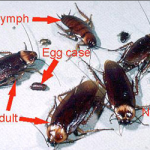American Cockroaches are sometimes known as Water Bug or Palmetto Roaches. This largest of the common household roach did not originate in America but came in shipped cargo from Africa in the early 1600’s. While it is possible to have large numbers occur inside a home most infestations are not nearly as heavy. Preferring warmer temperatures and feeding on decaying organic matter this roach is best suited for outdoor living. Not tolerant of cold weather this roach will move indoors but will not thrive without high humidity or moisture. 
Once adulthood is reached this roach can live up to a year and produces about 150 young. Egg cases (oothecas) are rather large brown capsules that protrude from the females back side until she drops them either in a secluded place or she secures them on a wall or other semi protected surface. Babies emerge in 6 to 8 weeks and take anywhere from 6 to 12 months to mature. As mentioned they feed on organic matter but fermenting food is also a favorite for this scavenger. Generally the body is reddish brown in color with a yellow area on the thorax or back of the head.
How They Travel
The American roach is very fast moving and has been clocked at 5.4 mph which is comparable to a human running 210 mph. Able also to
fly this roach is one that brings out the most fear in homeowners who find this large behemoth suddenly on their floors or wall. American cockroaches are not attracted to lights but often seek shelter in homes as the cold weather sets in. Their large size limits many points of entry but they are surprisingly good at fitting through small cracks or gaps in a wall. Perhaps attracted by the heat of a home or seeking moisture in dry climates this roach often invades basements, garages or screened porches. American roaches are very capable fliers.
How Best To Identify American Roaches
Size is the best indicator but the Australian and Oriental roaches are also close in length and width. Oriental roaches are black however and Australian roaches although similar in color have a visible yellow stripe on the outer edge of each wing and the American does not. No other common roach comes close in size as these 3 with American being the longest at 1 and 1/2 inch when fully grown.
Treatment And Elimination
Heavy or persistent infestations usually indicate a moisture problem either inside which is sustaining them or outside which allows their population to thrive and wanderers constantly find their way. Leaky pipes, damp basements or crawl spaces, faulty gutters or roof shingles that provide moisture will allow for American roaches to thrive indoors. Heavy mulch, shrubbery or unchecked sewer systems contribute to population booms and the roach numbers can get quite high. Eliminating or at least reducing moisture problems is the first step to American cockroach control.
Since this pest often enters wall voids through pipe lines, wood rotted siding or soffits, crawl spaces or other openings, dusting the voids is very beneficial. Inside voids in basements, under sinks, where utility pipes enter, drop ceilings, in garages under shelves and behind storage and other voids will provide long lasting barriers. Exterior entry points such as cracks in foundation, base of siding, around doors and windows, voids around light fixtures and areas of wood decay or other gaps should be dusted thoroughly to stop this roach from entering.
Liquid sprays do a nice job for American roach control in cracks and crevices or as spot treatments where dusts are not desirable. (areas that are not a void or generally inaccessible) Inside places to spray might include in dark areas where this roach may hide such as under refrigerators, under sinks or cabinets, baseboard cracks or gaps, doorway areas, behind furniture, exposed ceilings along walls in basements or near areas of moisture such as around but not in sump pumps. Outside areas may be around doors and windows, eaves and gutters, base of home and gaps, cracks or other entry points this roach may use.
Baits are an excellent choice for control and can be used both inside and out. Attics, wall voids, garages, around sump pumps, under refrigerators or basement stairs or furnishings and in utility rooms to name a few are great places to bait. Outside baiting is best in mulched and landscaped areas, in, under and around sheds, under planters, splash blocks, wood piles, grills, idle cars or boats, railroad tie walls or other landscaped features.

Leave a Reply